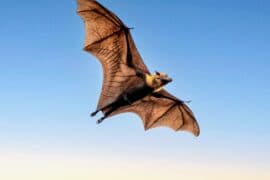African river-martin
(Pseudochelidon eurystomina)
Description
The African river martin (Pseudochelidon eurystomina) is a passerine bird,one of two members of the river martin subfamily of the swallow family,Hirundinidae.When discovered,it was not initially recognised as a swallow,and its structural differences from most of its relatives,including its stout bill and robust legs and feet,have led to its current placement in a separate subfamily shared only with the Asian white-eyed river martin.The African river martin is a large swallow,mainly black with a blue-green gloss to the head and a greener tint to the back and wings.The under-wings are brownish,the underparts are purple-black,and the flight feathers are black.This martin has red eyes,a broad orange-red bill and a black,square tail.Young birds are similar in appearance to the adults,but have browner plumage.This species has a variety of unmusical calls,and displays both in flight and on the ground,although the purpose of the terrestrial display is unknown.The main breeding areas are in the Democratic Republic of the Congo (DRC) along the Congo River and its tributary,the Ubangi,in habitats characterised by a mixture of tropical forest types including swampy or seasonally flooded woodland.The African river martin is migratory,wintering in coastal savanna in southern Gabon and the Republic of the Congo.Breeding also occurs in these coastal areas,but it is unknown whether the migrants are raising a second brood or if there is a separate resident population.This martin feeds in flocks throughout the year,catching a variety of insects in the air,especially flying ants.It does not use perches during the breeding season,although it will often land on the ground.The African river martin nests in burrows in river sand banks,often alongside rosy bee-eaters,but its incubation and fledging times are not known.It also digs tunnels for night-time shelter when in its wintering areas.It appears to be common within its restricted range,despite being caught in large numbers by the local population for food,and large flocks are sometimes seen.However,due to a lack of detailed information about its breeding range and population numbers,this species is classed as Data Deficient by the International Union for Conservation of Nature (IUCN).
Taxonomic tree:







